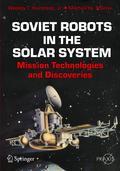
Soviet robots in the solar system: mission technologies and discoveries
Huntress, Wesley T.
Marov, Mikhail Ya
Soviet Robots in the Solar System provides a history of the Soviet robotic lunar and planetary exploration program from its inception, with the attempted launch of a lunar impactor on September 23, 1958, to the last launch in the Russian national scientific space program in the 20th Century, Mars 96, on November 16, 1996. This title makes a unique contribution to understanding the scientific and engineering accomplishments of the Soviet Union’s robotic space exploration enterprise from its infancy to its demise with the collapse of the Soviet Union. The authors provide a comprehensive account of Soviet robotic exploration of the Solar System for both popular space enthusiasts and professionals in the field. Technical details and science results are provided and put into an historical and political perspective in a single volume for the first time. The book is divided into two parts. Part I describes the key players and the key institutions that build and operate the hardware, the rockets that provide access to space, and the spacecraft that carry out the enterprise. Part IIis about putting these pieces together to enable space flight and mission campaigns. Part II is written in chronological order beginning with the first launches to the Moon. Each chapter covers a particular period when specific mission campaigns were undertaken during celestially-determined launch windows. Each chapter begins with a short overview of the flight missions that occurred during the time period and the political and historical context for the flight mission campaigns, including what the Americans were doing at the time. The bulk of each chapter is devoted to the scientific and engineering details of thatflight campaign. The spacecraft and payloads are examined with as much technical detail as is available today, the progress is described, and a synopsis ofthe scientific result is given. Presents a detailed, technical description of Soviet robotic space flights. Provides an historical timeline of missions and programs in the context of competition with the US. Outlines Soviet planning in both a national and international political context. Covers mission objectives, spacecraft engineering, flight details, scientific payload, and results. INDICE: Illustrations. Author's Preface. Acknowledgments. Part 1: The pieces: people, institutions, rockets and spacecraft. Chapter 1: Space race. Chapter 2: Key players. Chapter 3: Key institutions. Chapter 4: Rockets. Chapter 5:Spacecraft. Part II: Putting the pieces together: flying to the Moon, Venus, and Mars. Chapter 6: Breaking free of Earth. Chapter 7: Launching to Mars and Venus. Chapter 8: New spacecraft, new failures. Chapter 9: Three more years offrustration. Chapter 10: Finally success at the Moon and Venus, but Mars eludes. Chapter 11: Robotic achievements in the shadow of Apollo. Chapter 12: Landing on the Moon, Venus, and Mars. Chapter 13: Closeouts on a Venus spacecraft,a Moon rocket, and desperation at Mars. Chapter14: Turning from the Moon and Mars to Venus. Chapter 15: Repeating success at Venus. Chapter 16: Back to Venus again. Chapter 17: And back to Venus yet again. Chapter 18: The International Comet Halley campaign. Chapter 19: Another try at Mars and its moon Phobos.Chapter 20: The last gasp: Mars-96. Chapter 21: The Soviet lunar and planetary exploration legacy. Appendices. Bibliography. Index.
- ISBN: 978-1-4419-7897-4
- Editorial: Springer New York
- Encuadernacion: Rústica
- Páginas: 460
- Fecha Publicación: 28/08/2011
- Nº Volúmenes: 1
- Idioma: Inglés
